State of Online Courses 2017 (Industry Survey of 830 Entrepreneurs)
Lexi Rodrigo
Editor’s Note: The State of Online Courses is now The State of Online Learning. Read the 2018 report here.
Is it just me or did online courses just become hot?
In the last two months alone, I’ve seen three internet marketers launch training programs on how to create and sell online courses (I’m sure there were more who weren’t in my radar).
And we’ve discovered that there are a gazillion online course platforms, learning management systems, and marketplaces for course creators.
So many more people are talking about online courses, am I right?
I’m pretty confident about this, because we’ve got the numbers to prove it.
Since 2015, we at Mirasee have been surveying our audience of service providers, independent professionals, and entrepreneurs to gauge their interest and progress in course building.
In 2016, 830 of you completed the survey (thank you very much!), and here’s what they said:
It’s Cool to School (Online)
Virtually every respondent (93% of them) was interested in online courses and, in fact, 51% have done something about it:
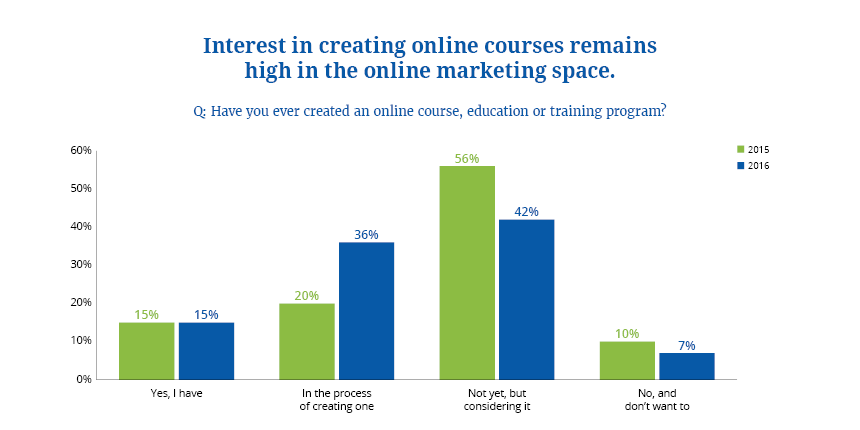
As you can see, the interest in online courses has remained steady since 2015, except for one thing: more people are in the process of building their online course in 2016 (36%) than in 2015 (20%).
No surprise then that fewer people are still thinking about it in 2016 (42%) than in 2015 (56%). Which makes perfect sense, if you think about it, since the respondents are part of Mirasee’s audience 🙂
This explains the increased flurry of activities around online course building. Where there is a lot of interest, naturally vendors will respond by providing what they need. In this case, it’s training on how to build online courses and the tech tools to create and sell them.
Now, what about these outliers who have no interest in online courses whatsoever? What’s up with them?
Turns out, the majority of them don’t feel they have the time to put into building and selling online courses (44%)—a perfectly valid point! They probably recognize online courses as a good way to make money online, but it’s just not feasible for them right now due to time constraints.
But then 36% simply haven’t included online courses into their business model. Oooh, what will it take to convince them, I wonder? If they stick around with us longer, maybe we can get them to the “Light Side.” 🙂
“It’s a fantastic business model for those content creators who know what they’re doing, have their students’ best interests at heart, and have the follow through to fully execute their ambitions.” Sean Platt, author and course creator
I’d also like to point out that the other concerns seem to stem from a lack of confidence in their ability to put out an online course. Confidence (24%) is fifth on the list of constraints, but it seems that Experience or Expertise (27%), and Course Content Creation (25%) are confidence issues as well. Respondents don’t think they’re enough of an expert to teach others online, and they’re worried about creating course content.
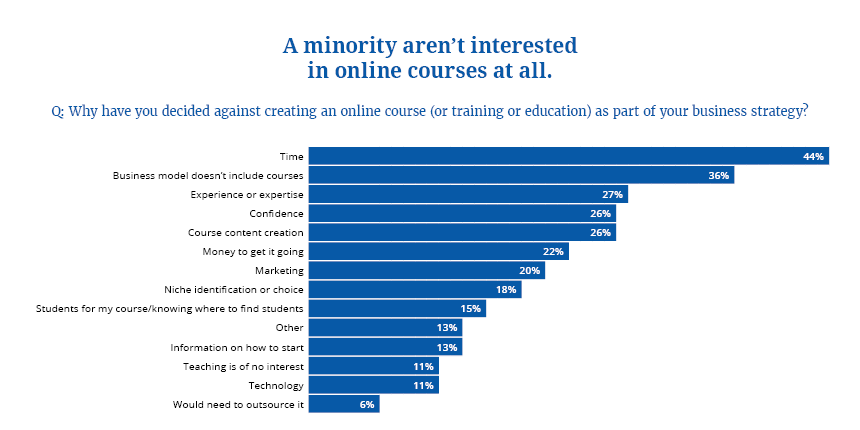
Now let’s go back to the vast majority of the respondents who are either interested or already in online courses building.
Giving… and Receiving
When asked what motivates them to create and sell online courses, the respondents displayed a healthy balance of wanting to give and to receive. The top answer is “to share my knowledge,” followed closely by “to make money,” with slight variations between those who already have an online course and those who are still thinking about it.
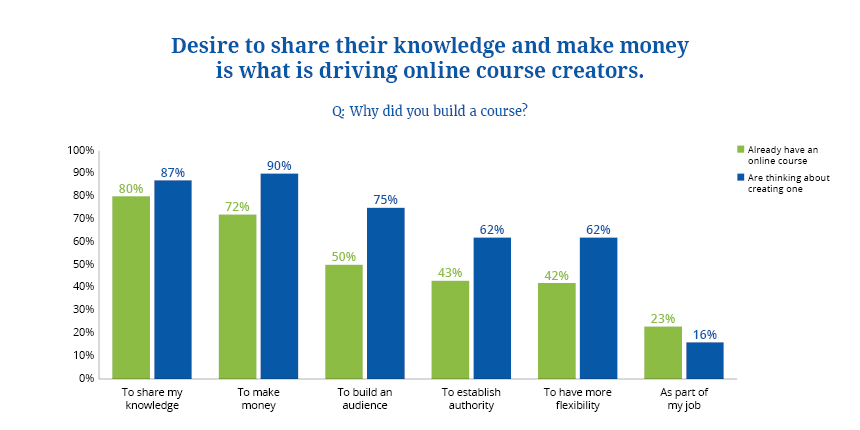
Why is all this significant? We asked respondents what succeeding with online courses means to them personally. An almost equal number said their biggest reason why is to help people reach their goals (35%) and to achieve their income goals (34%).
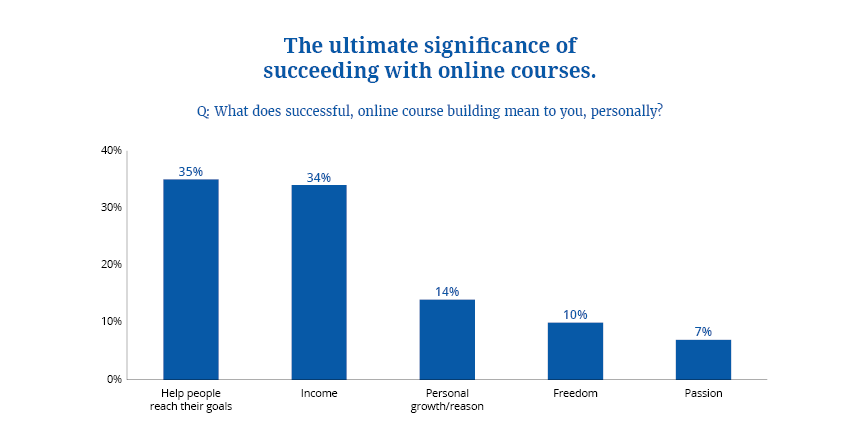
All this is consistent with what Danny Iny, Mirasee founder and CEO, says in his book, Teach and Grow Rich: online course creation is one way to (1) make a meaningful impact to the people you want to serve, (2) achieve your income goals, and (3) have the lifestyle freedom you wouldn’t otherwise enjoy in a traditional job or even a brick-and-mortar business.
Reality Bites: It’s Not All Unicorns and Rainbows
In an ideal world, online course creators will have students who succeed in completing the course and achieving transformation as a result of it (57%), enough students enrolled in their courses (23%), and as a result, make enough money through their courses (21%). These are the top indicators of a “successful” course.
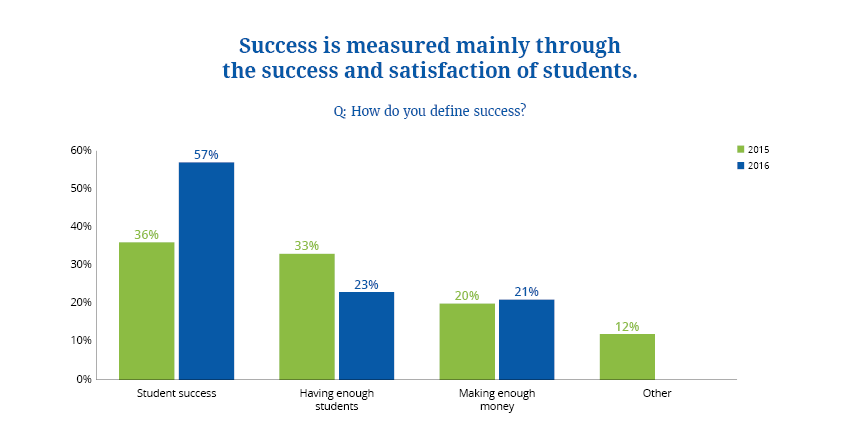
When asked to compare their actual results with these ideals, about half (53%) of online course creators consider their course somewhat of a success. Only 17% say their courses were definitely successful. A third of the respondents say their courses were somewhat to definitely not successful.
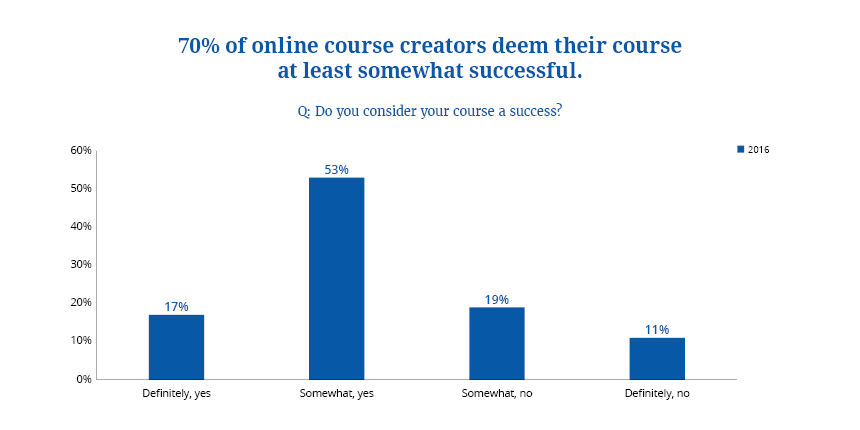
“What I’m most pleased about is the dramatic increase in creators who view student success as the primary measure of a successful course. However, the fact that proportionately few creators believe that their course is definitely successful means that there’s much more work to be done. Furthermore, the biggest challenges that creators are identifying (marketing) and the measures they’re using for success (creating a quality learning experience) don’t align. Until they do, and creators start putting more emphasis on the challenge that is crafting a quality learning experience, they will continue to miss the mark with student success.” Breanne Dyck, Founder, MNIB Consulting Inc.
Where does the dissatisfaction come from?
Part of it may stem from the fact that they’re not getting as many students as they hope to, and they’re not charging the prices they want to charge.
Look at the glaring gap between how many students aspiring course creators want and how many are actually enrolling in our respondents’ courses. While 44% of aspiring course creators hope to get over 1,000 students, only 9% of those who’ve built courses have in fact had that many students. On the other end of the spectrum, only 8% have the modest goal of 6-20 students. But that appears to be the most common enrollment size for our respondents (30%).
And here’s the worst part: 19% have had fewer than 5 students! A number which, understandably, not a single one of our respondents was aiming for.
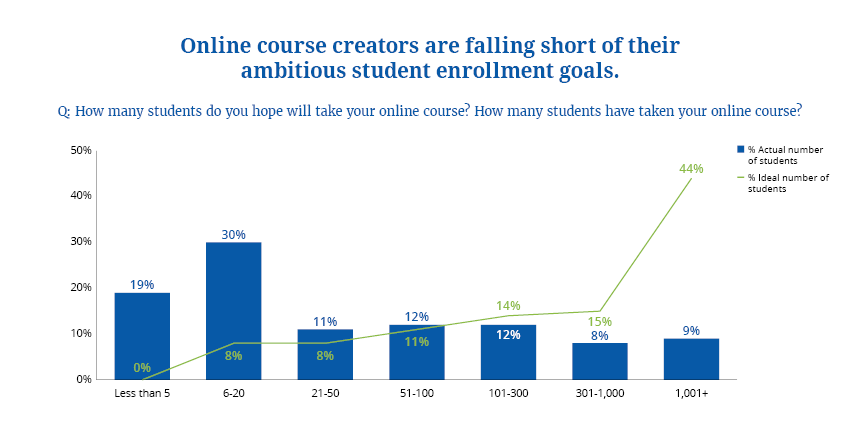
Some experts feel this is an unrealistic expectation:
“They don’t realize what it means to have 100, 300 or 1000(!) students in a course…. a class of 1000 might require 5 or 6 full-time teachers and assistants to give students a worthwhile experience. Yes, we all wish we had 1,000 online students paying $499 each and that this required just 4 hours per week to manage, but that’s just not realistic if you plan to deliver an education and not just information, even with current technology. More realistic are the 16% of survey respondents who expect 50 or fewer students. This still may be a full-time job but a manageable one where a good instructor can deliver an outstanding online course experience.” Matt Champagne, Course Creator and Author of The Survey Playbook
Others think it’s premature to hope for over 1,000 students so early in the game:
“For me, the missing component in the online course space right now is building a massive tribe that will buy any course you release, and I think that’s reflected in the survey data. The reason so many people are struggling to get the number of students they want is because they are creating a course and then searching for people to buy it, not building their tribe in advance.” Jon Morrow, Course Creator and Founder, Smartblogger.com
The pricing situation is not much better.
When you look at the price points from $100 and beyond, you see gaps between how much course creators want to charge and how much they in fact charge. There’s a huge gap in the $300-499 range: 23% of aspiring course creators want to charge that price, but only 13% of course creators have done so.
But the largest gap of all is in free courses: Almost nobody (1%) wants to give away their course, but 19% do.

Curiously, only 9% want to charge $1,000 or more. Is it because they don’t think the market will pay that much? Or is it because they don’t think the value of their courses is $1,000 or higher?
“In terms of impact and income, many online courses are failing.”
Tweet Me
The most desirable price point seems to be between $100-$299—which would be terrific, if course creators were getting their targeted 1,000+ students. That’s a minimum of $100,000, which makes a pretty good annual income.
But sadly, most online course creators don’t experience this. The most common number of students is 20 and the most common price is up to $299. That makes for a grand total of $5,980. This means they don’t get to quit their day jobs. They don’t get to help as many people as they want to. And they don’t get to enjoy the lifestyle of their dreams.
Even though our respondents’ courses may be effective, in the sense of creating transformation for their students, they’re neither getting enough students nor charging as much as they want to. In terms of impact and income, many online courses are in fact failing.
The X Factor of Online Course Building
When asked about their biggest impediment to success, respondents answer slightly differently, depending on whether they have already created a course or are still thinking about it.
For those who already have an online course, the top challenges are marketing (73%), technology (40%) and time (39%), course content creation (27%), and niche identification (20%).
“The biggest hurdle facing online course creators is they have to use different tools than creating a book or blog post. Unlike a book, you have to think about the nonverbal messaging in a course…. Students will push back if video quality is not up to snuff or there is not enough face to face time—that is videos where someone can see a face. It is incredibly important for creators to understand the power of ‘Competence Body Language’—how to appear confident and composed on camera. As well as teachers need to understand how to gain engagement with facial expressions and voice tone. If you want a successful course don’t just think about what you will teach, think about how you will teach it.” – Vanessa Van Edwards, ScienceofPeople.com
But for those who want to create an online course, time (64%) is the main challenge that’s keeping them from following through on this desire. But even this group who doesn’t have a course to sell yet is already anxious about marketing (55%). It’s an even bigger concern than technology (45%), course content creation (38%), niche identification (26%), and other frustrations.

Either way, marketing seems to be the X factor. And our respondents have a point. Effective marketing will help them fill their courses and charge the price that makes online courses worthwhile.
“Many do not achieve the level of success that the owner originally envisioned for their course. It’s easy to come up with an idea, and it’s relatively easy to build a product. But marketing and selling it, most people just don’t have that skill. They should put 80% of their efforts into marketing and sales, and 20% into product creation. Most are the opposite, spending all of their time on product creation…and very little on marketing and sales.” Josh Turner, Creator of LinkedSelling and Linked University
Stay Tuned
So here’s the situation.
More and more people are trying their hand at creating online courses. They want to share their knowledge, make money, and reach more people. But these expectations aren’t being met. They’re not getting nearly as many students as they hoped to enroll. And they’re not able to charge as much as they want to.
They know that they need help with marketing, most of all. They also want help to use the technology involved and either finding or making time for course building.
Will the industry meet their needs? Will they be committed enough to overcome the challenges of online course creation (or any business for that matter) and eventually achieve their goals? What do you think?
Find a Sellable Topic for Your Online Course!
Get this primer and learn our process for identifying a viable topic for your very first online course.
Diane
Your article did not surprise me one bit! Clearly entrepreneurs want to make money and selling is the name of their game. However, helping, educating and teaching is not a game – rather it’s a passion that fueled by emotional reward, changing lives, and giving. Perhaps if marketers would give without the possibility of getting, they would see their numbers grow exponentially – look at the Khan Academy!
Amar kumar
Hey Lexi,
Glad to read your informative post and I’m totally agree with your whole points. Online open courses really makes education easier for everyone, we know very well today in new era technology makes comfortable and easy for everyone in any-field. Day by day, education level is growing with online courses.
Online courses will be very helpful to generate high profit by effective strategies such as while selling online courses in specific enrollment periods, helpful to generate large group of students. Eventually, thanks for reveling a light on this wonderful burning topic.
With best regards,
Amar kumar
Lexi Rodrigo
Hi there, @Amar, great to see you again! Online education is such an exciting topic. I believe the best is yet to come, as more indie course creators enter the market and online courses become as mainstream as YouTube 😀
Laurence Ward
Good article. The most important point you mention is the one that most course creators miss. And that is the need to establish a market first by building a good relationship with a tribe or perfect prospects and then offering them your course as the perfect solution to their problem or pain. The second point is the need to either gradually build up the number of students so they can be properly managed, or come up with a viable group setting where the students themselves are taught how to help and support each other with the course creator as the facilitator. Otherwise as you pointed out, things can get out of hand very quickly.
Lexi Rodrigo
@Laurence – Thanks for dropping by and leaving a comment! The value of “community” in online courses is coming up as an important theme in our discussion with online education experts. More on that coming soon!
Calvin Black
Like Lizzie above I think this summary is a great reminder to build your connection with your audience and develop content slowly and methodically as you figure out what meets their needs. Mirasee’s formula and expertise in this are invaluable.
Lexi Rodrigo
Hey there, thanks for your kind words, @Calvin!
Lizzie
Great article Lexi!
I found it especially interesting that 44% of folks would like to have 1000+ students. Having taught in the classroom and online, I can say that 1000 students is more than one person can manage.
1000+ students is a goal to build up to, for sure! But starting out, it is so much better to have a small number of students to learn and grow with.
Loved the graphs as well. Thanks!
Lexi Rodrigo
@Lizzie – Excellent point about starting out with a small number of students. Guess our audience would eventually like to have an online course empire, possibly with their own support teams to take care of their 1,000+ students.
jp
Not all courses are built the same, I have a few thousand students, and welcome thosusands more. Scale is no issue. Someone buys the course, goes through it on their own, their is no interaction, or comments or live training – it’s a digital equivalent of a learning book but on video. But I still get great feedback via email that they reached their goal. Meanwhile I focus on the marketing 🙂
Lizzie
Hi JP,
Thanks for your note! I’m curious – did you go through a few versions of your course before creating the current version it’s in?
How did you know that students would be successful?
What do you do within the body of the course to encourage people to continue on, not give up, and eventually complete it?
Thanks again!
Lizzie
Richard @ e-Courses.xyz
Wow!!! This is an awesome study and nearly in line with what I was thinking about the industry. You’re right, ecourses are taking off everywhere. I’m a bit late to the game I guess, but I just started a site of my own to help bloggers and individuals develop, and promote their own ecourses. It’s brand new but with what I’m seeing in the industry, it seems to be a needed additional source for marketing an ecourse. I’m also in the process of developing my own ecourse so this study is even more relevant to me. Thank you.
Lexi Rodrigo
@Richard – Hello! Thanks for your comment. I don’t think you’re late to the game yet, because as you can see from our survey results, online entrepreneurs are still trying to figure this stuff out. I hope you’ll check back frequently, because we’re going to publish a ton of content for course creators. Watch out for it!
Ed Oz
Thanks for publishing this very useful article. Top notch writing and very useful graphs. I am considering an online course creation and it is perfectly timed. I will follow your articles..
Lexi Rodrigo
@Ed Oz – Hi there and thanks for stopping by! I’m glad you found the article useful and that you’re thinking of becoming an online course creator yourself. Do keep checking back because we have lots more content for you 😀